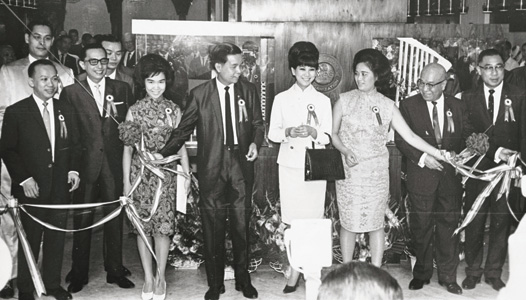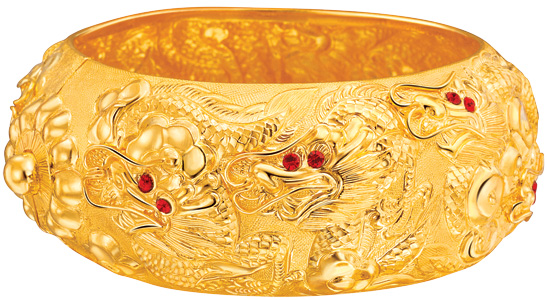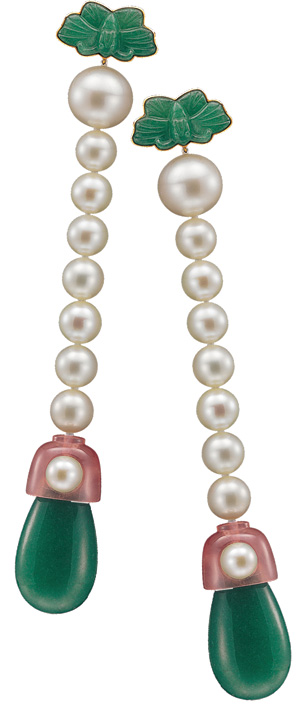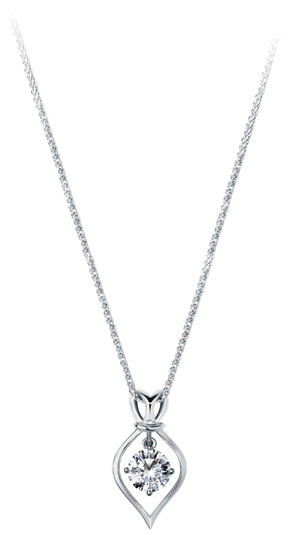
|
Vintage photo of shop opening with Cheng Yu-Tung in the center.
Photos courtesy Chow Tai Fook.
|
To Westerners, Chow Tai Fook may be an unknown name, but to
millions of Chinese, the name is considered equivalent to Tiffany & Co. or
Cartier. This 83-year-old powerhouse recently launched an initial public
offering (IPO) in Hong Kong that raised $2 billion to fund future growth and
expansion. As China’s — and the world’s — biggest jewelry retailer, Chow Tai
Fook offers a wide range of merchandise, from ultra-high-end diamond and
gemstone jewels — mostly in the flagships in major cities — to traditional,
midrange “mass luxury” designs, as well as newer collections of mass-market and
fashion jewelry aimed at professional women and younger customers. The company currently operates
approximately 1,600 retail outlets…and counting. Built on the country’s love of
gold and gold jewelry, the company now plans to tap into China’s newly
developed love for diamonds and diamond jewelry.
Background information on Cheng Yu-Tung and the early days
of the jewelry company is a bit vague and the family released few details in
the IPO prospectus, other than the fact that the company’s origins stretch back
to 1929 and the first retail store was established in Macau in 1938 and the
first Hong Kong store in 1939. But a December 2011 profile by The Wall Street
Journal reported that Cheng fled China as a teenager and landed in Macau.
There, The Journal reported, he was taken in by a family friend, Chow Chi-Yuen,
and began to apprentice in his gold shop. The shop was named Chow Tai Fook — Tai
Fook translates as “big blessing” in Chinese. Cheng married Chow’s daughter in
1943 and began expanding the Chow Tai Fook empire in Hong Kong and Macau.
In 1956, Chow Tai Fook is credited with introducing gold jewelry
and objects made of 999.9 “pure” gold in Hong Kong and Macau. The diamond
business followed. In 1973, Zlotowski’s, a DTC sightholder, became Chow Tai
Fook’s related party, and in 1988, the company aligned itself with a diamond
processing and jewelry manufacturing plant on the Mainland. Both firms became
subsidiaries of Chow Tai Fook in 2011. In 1993, Chow Tai Fook became a DTC
sightholder, allowing it to source its own rough. It also has Select
Diamantaire status with Rio Tinto.
Until the completion of the IPO, which occurred on December
15, 2011, the company was owned and controlled by the Cheng family. The company
is focused on Greater China and the Chinese market, with approximately 90
retail outlets located outside the country, in Hong Kong, Singapore, Malaysia,
Macau and Taiwan. Cheng has been named by Forbes Magazine as Hong Kong’s
fourth-richest man.
RAPID RETAIL GROWTH

|
Dragon and phoenix bangle.
|
Chow Tai Fook’s retail expansion has been rapid. In 1998,
the company opened its first store in Beijing, in the People’s Republic of
China (PRC). By 2010, it was opening its one thousandth store there. With the
new capital from the IPO, the company plans to open 200 stores per year,
bringing the total to more than 2,000 by 2016.
The stores themselves cover a wide swath of styles, from
multifloored luxury emporiums in major cities, such as Hong Kong, Macau and
Shanghai, to smaller, street-front shops in less populated locations to jewelry
boutiques in department stores. In addition, more than 862 jewelry concession
counters are located in major department stores, which represent the majority
of the company’s points of sale. In the major cities, it’s not unusual to find
several branches just one shop away from each other in the most popular
shopping areas.
The Chow Tai Fook shops situated in the downtown shopping
districts in Hong Kong, Beijing and Shanghai dazzle viewers with large show
windows, each devoted to jewelry of specific materials. For example, several
windows are filled with diamonds; others showcase emeralds, rubies, sapphires
or pearls. Almost half the windows are devoted to luxury watch brands,
traditional jewelry and articles made of 24-karat gold. Prices are posted
clearly in front of every piece.
Of course, in a country as large as China, where eight
primary language families and an infinite number of dialects are spoken, and
with differing customs and economic conditions, the merchandise mix can vary
widely according to each market. For example, in smaller stores in Tier II and
Tier III cities, Chow Tai Fook can be found on the main floor of an established
department store, offering a range of midpriced products, including diamond and
gemstone jewelry, pearls, jade and, of course, gold.
COMPANY MANUFACTURED

|
Jade and pearl earrings.
|
The great majority of jewelry sold in the Chow Tai Fook stores
— and 80 percent of the gem-set jewelry — is produced in the company’s own
factories, one of which is in Hong Kong and the rest in China’s Guangdong
Province. About 60 percent of the retailer’s diamonds, an important portion of
the company’s sales, are purchased from trade dealers and wholesalers.
Approximately 40 percent of Chow Tai Fook’s diamonds are produced from rough
diamonds — some of which it sources itself — and polished at one of its three
diamond-cutting and polishing factories in South Africa and Mainland China.
In a recently published interview in Women’s Wear Daily,
Adrian Cheng, executive director of Chow Tai Fook and Cheng’s grandson, said
that while Chinese customs remain the same, consumer tastes are changing. For
example, it is the custom to purchase and give jewelry as gifts for important
holidays and commemorations. Usually, in Chinese gift-giving tradition, gold
products are most popular for weddings and baby gifts, he said. These include
both gold jewelry and ceremonial articles of so-called chuk kam, 24-karat
“pure” gold. However, he noted that in recent years, Chinese consumers have
“become more interested in gem-set jewelry, especially for birthdays,
anniversaries, or Western festivals such as Valentine’s Day and Christmas.” He
also noted a growth in high-end clientele who opt for specially designed or
unique items.
MASS LUXURY & YOUTH LINE
Right now, the great bulk of Chow Tai Fook’s retail sales
fall into the mass luxury segment, that is, jewelry retailing from $250 to
$13,000 each. A high-end collection, inspired by both European design and
Chinese culture, satisfies the luxury customer in major metropolitan outlets
and a newly developed youth line, featuring more casual designs and
Disney-licensed products costing less than $250 apiece, is addressed to a
younger audience. At this point, the company expects the high-end level to
remain relatively stable, but the mass luxury and youth markets to grow.
In addition to gold, jade is a traditional favorite among
Chinese consumers. Jadeite of a deep emerald green color is highly sought after
and styled into pendants, rings and bracelets, often accented with yellow gold
and diamonds. Of growing interest to Chinese consumers are diamonds and diamond
jewelry, ranging from Western best sellers such as engagement rings, solitaire
pendants and line bracelets to more elaborate fashion items, usually composed
of small stones. According to published reports, China is second only to the
U.S. as the world’s largest diamond consumer, spending $1.5 billion annually on
diamonds and diamond jewelry. It is estimated that China will surpass the U.S.
to become the largest diamond-consuming country by 2016.
THE STEPS TO EXPANSION
At a seminar during the recent Hong Kong International
Jewellery Fair, Kent Wong, Chow Tai Fook’s managing director, revealed how the
company achieved its notable expansion (see page 56 for Kent Wong interview).
A critical ingredient in the expansion was extensive market
research. One encouraging statistic revealed that between 2006 and 2010,
disposable income in China rose 12.9 percent on a compound annual growth rate
(CAGR) basis, opening the door to additional luxury purchases. “China is a
country of gift giving and, whenever there is a festival or an occasion for
celebrating, Chinese people like to present jewelry as gifts.” Jewelers should
capitalize on the golden time slots of festivals, Wong said, purchases that are
not affected by economic conditions.
Chow Tai Fook initially moved into the Chinese market by
setting up franchises and links with established stores, such as department
stores. To stand out from the throng, a company can set up retail networks in
different cities, either by running its own shops or through franchising, Wong
said. “By the expansion of the retailing channel, a company can make contacts
with consumers at different levels.”
“Department stores are the most important channel,”
continued Wong. “Mainland consumers generally believe that only jewelry bought
from department stores has a guarantee of quality, as well as getting better
after-sale services. Having over 80 percent of our self-owned jewelry points of
sale in department stores entails lower start-up costs and allows contact with
target consumer groups, an effective strategy in venturing into the retail
markets of nonmajor cities.”
Chow Tai Fook’s first targets were larger provincial
capitals, where one can get higher margins and establish a stronger image. The
next step was to enter smaller regional locations. Among the company’s
challenges for the future is that the fastest growth is coming from these
smaller cities, where population and income are growing faster, Wong noted.

|
Perfect Mark diamond necklace.
|
EXPANDING NETWORKS
In addition to luring customers by expanding retail
networks, jewelers must become familiar with the consumer’s mind-set and
fashion trends, Wong advised. For example, in terms of product design,
“jewelers should introduce products that are appropriate to different life
stages of consumers, including those for celebrating births, coming of age,
marriage, job promotion, anniversaries, etc.” He further pointed out that currently close to one-third of
the Mainland population is of marriageable age, so there is substantial demand
for wedding jewelry.
Wong also believes that companies forging into the Mainland
market must pay attention to good customer service. “Building customer loyalty
is an important aspect, and jewelers can launch VIP programs to promote
high-price products with unique designs.” Chow Tai Fook has its own VIP
program, which accounts for 30 percent of repeat customer sales. The program
includes movie specials, birthday gifts, overseas trips and other perks that
are valued by its clientele.
THE POTENTIAL IS THERE
Finally, there is continued opportunity for expansion going
forward. Among Chinese consumers, there is still a wide gap in jewelry
ownership. For example, research shows that jewelry ownership among Mainland
Chinese is one-fifth that of Hong Kong and less than one-tenth of the U.S. and
Europe. Jewelry has taken over the lead from other luxury products and during
the 2010-to-2015 period, experts anticipate that jewelry purchases will
continue to grow at a faster rate than other luxury products.
Like its economy, the Chinese population is growing rapidly.
Its huge youth market — individuals born since 1990 — is accustomed to buying
jewelry that reflects style and status. Another targeted market is the
professional woman, who, like her Western counterpart, is earning her own money
and wants to buy stylish jewelry for herself. For jewelers, the growth
potential in China is tantalizing. There is a desire for jewelry and the
average Chinese consumer has a long way to go to match the jewelry ownership
enjoyed by Europeans and Americans.
Chow Tai Fook addresses the concerns of Chinese consumers in
buying jewelry for gifts or for themselves with its pledge of “sincerity,
eternity” pasted on billboards, displayed in subway stations and posted on city
buses for all to see.
“Quality and
brand are most important qualities and have to be a priority for any business,”
Wong concluded. “It is critical to build confidence in terms of quality and
marketing. The global economy is facing problems, but Chow Tai Fook is prepared
to meet these challenges.”
Article from the Rapaport Magazine - May 2012. To subscribe click here.